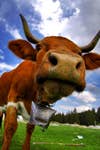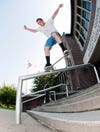10 Things You Should Know About Lenses
Follow these tips and you’ll be making better photos in no time.
We may earn revenue from the products available on this page and participate in affiliate programs. Learn more ›

The main job of a lens is to concentrate (focus) light rays so the film or digital sensor can record the scene. Put simply, the distance it needs to make the light rays converge completely is called the focal length. Lenses that bend light rays very effectively make them converge in a short distance. These short-focal-length lenses take in a very broad spread of light—a wide angle of view. Lenses with long focal lengths (telephotos) bend light much more gently, taking in a narrow field of view. There’s another factor in play here: The size of the film or sensor. Put a tiny sensor behind a lens and it will take in only a small amount of the image. A big sensor will take in a much bigger area. For this reason, bigger sensors need longer focal-length lenses, and smaller sensors need shorter ones, for the equivalent angle of view. In between are normal focal lengths, so called because they produce natural-looking perspective at moderate shooting distances. What’s normal? By convention, a focal length a bit longer than the diagonal measurement of the film frame or digital sensor. A full-frame sensor has a diagonal measure of about 43mm, so lenses around 50mm are “normal.” For APS-C-sensor cameras, which have a diagonal of about 28mm, a focal length of 35mm is considered normal. For Four Thirds cameras, 25mm. A typical compact has a normal of about 8mm. TIP: Set your lens to a normal focal length—even better, mount a normal lens—and force yourself to shoot a variety of subjects. You’ll find you’ll move around a lot more and you will discover different perspectives doing so. Dan Bracaglia

Try this experiment: Put your face very close to someone else’s (this tends to spook strangers). Notice how much bigger the person’s nose appears when you’re very close. Perspective distortion? Not really. It’s the natural perspective that occurs when your eye (or optic) is focused on something much closer than the mid- or background. This exaggerated scale isn’t really determined by focal length but by closeness—you can enlarge the size of your subject’s nose with a close-focusing normal lens, too. Wide-angle lenses let you focus on a very close object and still get lots of the background in the picture. Experienced nature shooters exploit this by using foreground objects—a shrub, a boulder, a fallen tree—to anchor the composition. With very wide-angle lenses, it creates a sense of great depth, almost an illusion of 3D. TIP: To maximize the near-far covering power of your wide-angle, shoot with the camera vertical. This way you can get everything from the grass beneath the cow, to the trees and sky behind her. rady one ツ

Here’s another experiment: Focus your longest lens on a distant group of large objects—mountains, buildings, trees—and take a shot. Now switch to a normal focal length, and without changing the position of the camera, shoot again. On your computer, blow up the distant detail in the photo from the normal lens. Surprise: The perspective will match that of the tele shot. The telephoto perspective of “compressed” distant objects— seeming stacked or layered on top of one another—isn’t produced by focal length but by objects all being relatively far from the camera. Your eye sees distant subjects this way, too, but you tend not to pay attention to it. Teles let you capture this kind of perspective without having to enlarge the image—and risk losing image quality in the process. By allowing you to back up from your subjects, they also let you take tight facial portraits without exaggerating features like noses. TIP: When working a landscape, don’t count on your naked eye to discern distant picture ops. Instead, scan the horizon through a long lens—lots of compositions will reveal themselves to you. Dan Bracaglia

One of the best and worst things to happen to photographers was the zoom lens. Best, because zooms let you change focal lengths without changing lenses. Worst, because they make you forget you have feet. If you stay in the same spot and hold the camera in the same position, you can zoom in and out as much as you want, but you won’t alter the perspective. For different perspective, you have to move. Zooms have another drawback: They typically admit less light (are “slower”) than prime lenses. The longer the zoom range, the slower they can be. And those that are relatively fast (i.e., f/2.8) tend to be pricey. TIP: When you take a shot with a zoom set to a long focal length, move yourself closer to the subject, if you can, to take another shot at a wider setting. It will give you a whole different perspective. djotai

Most lenses contain an aperture mechanism: a near-circular diaphragm that you open up or close down to control the amount of light getting through the lens. Aperture settings are stated in f-stops. These are simple ratios: the focal length of the lens divided by the diameter of the opening. So a 50mm lens with an aperture of 25mm is set to f/2 Close the aperture to 12.5mm and you’ve stopped down to f/4. The beauty of f-stops is their purity. F/8 is f/8 is f/8, the same exposure whether it’s made with a dinky compact’s lens, a big DSLR lens, or a lens on a large-format view camera. It also helps explain the relative size of lenses across formats. An 8mm f/2 lens on a compact can be tiny, while a 200mm f/2 lens for a DSLR needs to be one honking piece of glass. TIP: Think of f-stops as the size of the slice of sharp space they give you. A small number (f/1.4) will give you a small slice —shallow depth. A big number (f/16) will give you a big slice. Dan Bracaglia

The aperture also controls depth of field—the zone of acceptable sharpness in front of, and behind, a subject in focus. Very open apertures (small f-numbers: f/1.4, f/2, etc.) produce shallow depth of field, while very closed-down apertures (f/16, f/22, etc.) produce great depth of field with lots of the scene in sharp focus. Greater magnification (making the subject bigger in the frame) reduces depth of field; less magnification increases it. You can boost or reduce magnification by moving closer or farther from your subject. And, a tele lens helps you limit depth of field by allowing greater magnification, while a wide-angle helps you increase depth of field. One more thing: Very small sensors (compact cameras) give you vast depth of field, while big sensors (DSLRs) give you more limited depth. TIP: If your compact focuses manually, reduce depth of field by focusing to ever- shorter settings while watching the image of your subject. When it falls out of focus, move the focusing point the other way to keep your subject just sharp enough. Dan Bracaglia

_
7.Smallest is Not Best
Lenses are almost always sharpest at intermediate apertures, not the smallest. This runs counter to intuition: Since small apertures provide greater depth of field, you might think they’d provide maximum sharpness. Not so. Without getting into the science, the smallest apertures tend to degrade images. There may be more depth in the image, but if you blow up the area you focused on, you’ll almost always find it somewhat softer at small apertures than at larger ones. Photographers who want maximum sharpness in images will avoid smaller apertures for this reason. An old rule of thumb is that lenses tend to be sharpest at an aperture 2 to 3 stops down from maximum. On an f/2.8 lens, this would be f/5.6 to f/8. TIP: The SQF charts in our lens tests will show you the best aperture for sharp photos from that lens. Look for the area of the chart where the red squares extend farthest right. Dan Bracaglia

There are many accessories that can allow any lens to focus extra close. But for this task, nothing beats a macro lens. These are formulated to focus very tightly without any accessories, and are optimized for those distances. The close-focusing distance of a lens, though, is not a good measure of macro capability. (A 100mm lens that can focus to 4 inches will give you a tighter close-up than a 50mm lens that can focus to 3 inches.) Instead, macro lenses are rated by magnification, determined by the focal length divided by the closest focusing distance of the lens. That 100mm lens that can focus to 4 inches (about 100mm) is said to have a magnification of 1X, also called 1:1 or life size. Unfortunately, the term macro has marketing value, so makers of lenses with magnifications of, say, 1:5, call them macro. Not in our book. We list maximum magnification in our lens tests. TIP: When focusing at very high magnifications, it’s often better to move the camera back and forth than to turn the focusing ring. To be really precise, use a focusing rail. Dan Bracaglia

No lens is perfect, and some lenses are more imperfect than others. Among common imperfections, perhaps linear distortion is the most noticeable and annoying. This is the tendency of a lens to bow straight lines outward (barrel distortion) or inward (pincushion distortion). These days you can minimize distortion in your photos using software (see Software Workshop on page 46 to learn how). Because lenses bend light, they can also act as prisms and break light up into the component colors of the spectrum. Known as chromatic aberration, this appears as color fringing and softness, most noticeably at the edges of the frame. You can almost always reduce it by stopping down to a smaller aperture. Light falloff (vignetting) is the tendency of the lens to produce an image that’s darker at the edges, especially the corners. You can lessen it by stopping down or fix it later in software. Flare shows up as veiling fog and spectral blobs when you aim the camera directly at a bright light. Lenshoods can reduce this, and stopping down to a smaller aperture sometimes helps. TIP: Distortion is most severe at the very edges of the frame. With a distortion-prone lens, keep straight lines away from the edges by stepping back or altering the composition. Mustafa Sayed

Some lenses are designed to give you a very different view than you get with the naked eye. Fisheye lenses are probably the best known of these. These extreme wide-angle lenses are not corrected for distortion and can hence take in a much wider field of view than a conventional wide-angle. They can be full-field (the image fills the whole frame) or circular-image (the image appears in a circle in a field of black). Some lenses can be tilted in their mounts, which lets you manipulate the plane of focus. Fiddle with this one way and you can limit the focus to a very small area, with the rest of the image blurred out. Fiddle with it another way, and you can get nearly everything in focus. You can do this in a very precise way with expensive tilt-shift lenses, or in a more loosey-goosey fashion with a less expensive Lensbaby. These effects can, of course, be overdone, but they’re fun and can expand your horizons, literally and figuratively. TIP: Fisheyes are great for outdoor scenes, but they can be very effective indoors, too—in a tiny shop or a boat’s cabin, for example. Dan Bracaglia